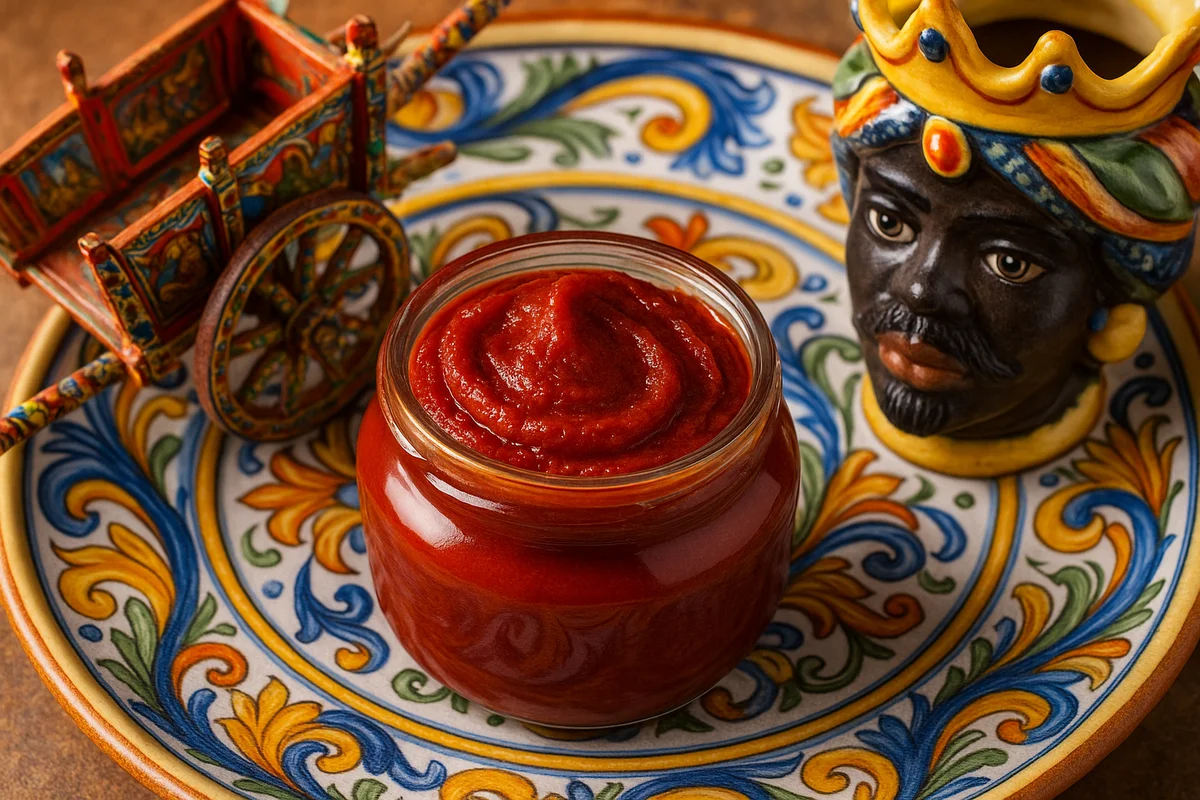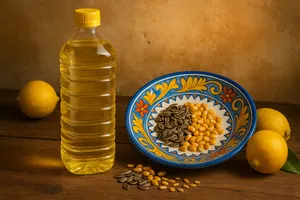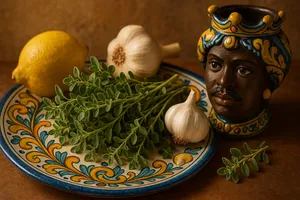Overview
Tomato extract, known in Sicilian as “strattu”, is a dense, deeply coloured paste obtained by slowly cooking tomato pulp—strained of seeds and skins—until it becomes thick, creamy and intensely red. This essential ingredient is one of the pillars of Sicilian cuisine, used to enrich sauces, ragù, soups and countless other dishes.
Traditionally, making tomato extract at home was an important summer ritual in Sicilian families. Ripe tomatoes were cooked, passed and spread onto large wooden boards (“tavulieri”), then left to dry under the scorching August sun for several days. The paste was regularly stirred until it reached the ideal consistency. This sun-drying method, handed down through generations, produced a concentrated, complex flavour that was preserved in jars to last the year—a treasured store of “summer in a jar”.
Characteristics
The extract appears as a thick, spreadable paste, deep dark red with a brownish hue. Its texture ranges from creamy to very firm, depending on the degree of concentration. When stored under oil, the surface may develop a light oily sheen.
The flavour is intensely tomato-forward, sweet-tart with caramelised notes due to long cooking and natural sugar reduction. Sun-dried artisan extract has a more complex and richer taste than industrial versions. Its aroma is strong, fragrant and characteristic of cooked, concentrated tomatoes.
Quality is evaluated by a uniform intense red colour, absence of dark spots or oxidation, smooth consistency, and balanced flavour without excessive acidity or bitterness.
Types
Artisanal sun-dried extract
The traditional Sicilian method relies on several days of sun-drying. It produces a uniquely rich, slightly caramelised flavour profile. It is the most prized type though highly labour-intensive and climate-dependent.
Double-concentrated tomato paste
Industrial product containing about 28–30% dry matter. Creamy, dense, and bright red, it is the most versatile and widely used form.
Triple-concentrated tomato paste
Even more concentrated, with 36–40% dry matter. Very dense, almost solid, with powerful flavour. Used in small amounts for long-simmered sauces.
Tube extract
A practical format, usually double concentrate, which helps dose the product easily and preserves well after opening.
Traditional preparation
Traditional Sicilian preparation followed a precise ritual. Ripe tomatoes were washed, cut and cooked in large pots. Once softened, they were passed through a sieve or tomato mill to remove skins and seeds, resulting in a thick juice.
This juice was spread over large wood boards covered with cloth and exposed to the sun. Throughout the day it was stirred with wooden spoons to encourage even evaporation. At night, the boards were brought indoors to protect the extract from humidity.
The process lasted 3–5 days depending on heat and humidity. Once it reached the desired consistency, the extract was gathered, salted, sometimes flavoured with basil, and stored in jars covered with olive oil to prevent oxidation.
Culinary uses
In Sicilian cooking, tomato extract is incredibly versatile.
Sauces and ragù
It forms the base of meat sauces, ragù and pasta sauces. Diluted with water or broth, it lends colour, flavour and density. A spoonful transforms simple dishes into rich, flavourful preparations.
Soups and stews
Added to vegetable soups, pasta-and-bean dishes and legume stews, it enriches flavour and colour. It dissolves easily into cooking liquid.
Braises
It deepens the flavour of braised meats, stews and meatballs in sauce. It gives the characteristic reddish colour to long-simmered dishes.
Pasta seasoning
When diluted with oil, garlic and basil, it becomes a quick sauce for pasta—perfect for a simple “pasta ca’ salsa”.
Enhancing prepared sauces
A spoonful added to tomato passata or canned tomatoes intensifies colour, sweetness and depth.
Pizza and focaccia base
Lightly diluted, it can be spread over pizza or focaccia dough before baking.
Dosage
Because tomato extract is highly concentrated, it must be used sparingly. For a sauce serving four people, 1–2 tablespoons of double concentrate are usually enough, diluted with water or broth.
Triple concentrate requires even less. It should be slowly diluted and tasted while cooking to avoid excessive intensity or acidity. Tomato extract should always be cooked for at least 10–15 minutes after being added to allow flavours to develop and acidity to mellow.
Storage
Industrial tomato paste keeps at room temperature until the expiry date. After opening, it should be refrigerated and covered with a thin layer of oil to prevent oxidation, and consumed within 1–2 weeks.
Artisanal extract stored under oil in sterilised jars lasts up to 1 year in a cool, dark place. It must always remain covered with oil, and a clean, dry spoon should be used to avoid contamination.
Tubed extract keeps longer—2–3 months—thanks to airtight packaging.
How to buy
When purchasing tomato extract, check that the ingredients list includes only tomatoes and salt, without additives or preservatives. The concentration level indicates intensity: double (28–30%) is versatile, triple (36–40%) is stronger.
The colour should be uniformly deep red, without darkened areas. Choose glass jars or tubes over cans to avoid any metallic taste. Organic tomato paste ensures reduced pesticide exposure.
If available, choose artisan sun-dried Sicilian extract: more expensive, but unmatched in flavour. Always check expiry dates.
Homemade extract today
Many Sicilian families still prepare tomato extract at home using modern methods. Today, slow oven reduction at low temperature (80–100°C) is common, stirring occasionally until thickened.
Although the flavour differs from traditional sun-drying, this technique produces an excellent paste even without ideal weather. Homemade extract made from quality tomatoes is always superior to industrial paste.
Nutritional properties
Tomato extract is highly concentrated: 100 g provide about 80–100 calories, 18–20 g of carbohydrates (mostly natural sugars), 4–5 g of protein and almost no fat.
It is extremely rich in lycopene—a powerful antioxidant—made even more bioavailable through cooking and concentration. Lycopene is associated with protective effects against some cancers and cardiovascular diseases.
It contains vitamins such as vitamin C (partially reduced by cooking), vitamin A and B vitamins. It is a good source of potassium, and also provides phosphorus, magnesium and iron. Its natural acidity aids digestion.
When stored under oil, the extract absorbs some fat, increasing calories but improving absorption of fat-soluble vitamins.
Curiosities
In Sicily, making tomato extract was an important social ritual. Families—especially women—would spend days stirring the extract under the sun while chatting and singing. Children were tasked with covering and uncovering the boards each night and morning.
The wooden boards used for drying were treasured and passed down through generations. Old, well-seasoned boards were believed to give better flavour. Today, these boards are highly valued by enthusiasts of culinary traditions.
In some areas, basil leaves were added during the final hours of drying to infuse a distinct aroma. Every family had its own secrets for perfect extract.
During World War II, when food was scarce, stored tomato extract became even more precious. Families guarded it carefully and used it sparingly to flavour humble soups of wild greens.
A Sicilian saying goes: “Cu' avi ‘u ’strattu avi u pani cunzatu” (“Who has tomato extract has seasoned bread”), highlighting how this simple ingredient could transform even plain bread into a satisfying meal with just oil and garlic.











